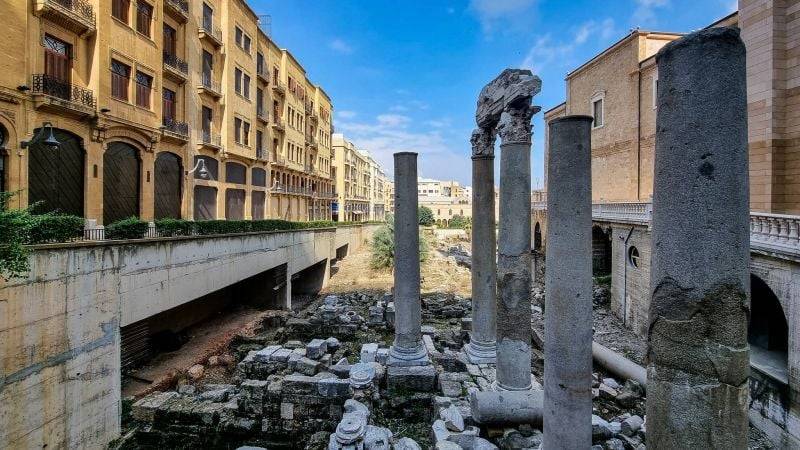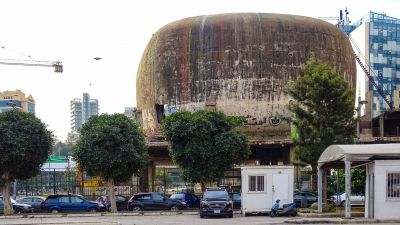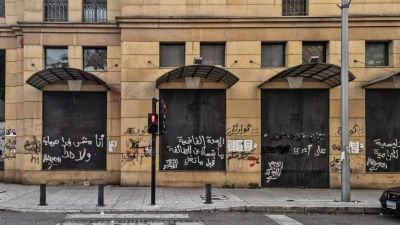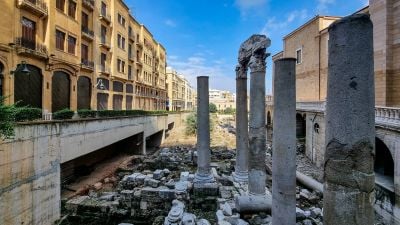
The columns of the Cardo Maximus of the Roman Berytus, February 23, 2023. (Credit: Camille Ammoun)
From East to West across Beirut, Tripoli Street (currently Armenia - Goureau - Emir Bachir) is streaked with several perpendicular axes that run across the city: Arax Street (named after a river in the caucasus); the Beirut river (known as the Magoras river in antiquity) and its two adjacent expressways (Emile Lahoud and Pierre Gemayel); The old Mar Mikhael railway bridge; the nightmare (hardly avoided) of yet another urban highway named after Fouad Boutros; the Georges Haddad urban rift (Georges Ibrahim Haddad, journalist and poet, martyr of May 6, 1916); Damascus and Bechara el-Khoury Streets, which lead to the Martyrs’ Square.
At the end of this psychogeographical journey that led us from the hills of Bourj Hammoud and Jdeideh landfills to that of Qantari and its Ottoman acropolis, through the grand bazaar that became the Grand Serail, the ancient traces of a final perpendicular axis calls to us: the Cardo Maximus, or the “Great Heart.”
The Cardo – from the Greek kardia (καρδίᾱ, heart) – was the main north-south axis of Roman Berytus (Beirut) and the cornerstone of urban planning at the time. In addition to a north-south axis, most Roman cities also had an east-west axis called the Decumanus Maximus. The Cardo and Decumanus were the main colonnaded streets of ancient Berytus. The Cardo connected the ancient city forum to a vast complex with mosaic floors that stretched from present-day Beirut’s Lazarist building to Riad al-Solh Square and it was the center of the Roman city.
Excavations uncovered a section of about one hundred meters of Berytus’ Cardo Maximus, where pedestals once supported six meter-high columns covered with colonnades on both sides of the street. Five of these columns have been replaced on site, in the heart of the aborted project of the Garden of Tolerance, which had it not been abandoned, could have been essential to our amnesiac city. Under this Garden that did not materialize we find the famous Roman law school of Beirut. The law school at Berytus was the main institution for the production of jurisprudence in the entire Roman Empire until the brutal destruction of the city during the great earthquake of July 9, 551. The earthquake that destroyed Roman Berytus was followed by a tsunami and a fire that wiped out the city. In all, 30,000 people perished in these disasters. Roman Emperor Justinian largely financed the reconstruction of Berytus but the once-famous law school was moved to Sidon and its best professors relocated to Constantinople.
The Roman Law school in Beirut acquired great notoriety within the Empire, so much so that Beirut became known as the "mother of laws". This reputation would reappear in modern times when, in 1913, Paul Huvelin, the first dean of the new law faculty of the Saint Joseph University, dedicated his inaugural speech to the ancient theme. To this very day, "Berytus Nutrix Legum" (Beirut, mother of laws) remains the motto of the Lebanese capital, and it is written on the seal and flag of the municipality of the city.
Zacharias Rhetor reports that the law school of Beirut (where he studied in 490 AD) was located next to the Temple of God, the description of which allows us to identify it with the Byzantine cathedral Anastasis, probably located under the current Greek Orthodox St. George Cathedral on the Cardo at the level of the Place de l'Étoile opposite the Parliament. A parliament made up of families, businessmen and traditional sectarian parties that have been perpetuated for decades thanks to clientelism and tailor-made electoral laws. Inside the parliament's walls, debates are more about sharing the cake, (or since the great collapse, about deflecting the blame onto others) than having a real conversation for the public good.
We move to the east-west axis of the city, known in Roman times as the Decumanus Maximus (today's Weygand street), parallel to our Emir Bashir street and a few steps away from the municipality. Written on the municipality’s flag is the motto "Berytus Nutrix Legum" (Beirut, mother of laws) ; the symbolic phrase has been systematically broken by a political class that excels in diverting the law in its own favor and paralyzing a judiciary that is in a perpetual fight for its independence. On this same street, a small nearby square shelters, under the shade of two bushy ficus trees, a quite atypical bronze statue.
Atypical because, contrary to most statues in this part of the world, it is not that of a president, nor that of a leader with exceptional military achievements, nor that of the founding father of an invented nation, but that of a sitting man. An intellectual. A journalist. An activist like those who were on the streets and squares during the memorable days of October 2019. A democrat like those who gather in cafes to discuss and try to understand (if not undo) the ingenious channels of corruption through which the oligarchs have looted for decades. This atypical statue gives the small piazza that shelters it, the name of the man it represents; it is the Samir-Kassir square, the square of freedom of the press, the square of Hrant Dink, the square of Anna Politkovskaya.
In this precise point, our walk crosses the Cardo Maximus of Berytus (the Great Heart of Beirut) and in this space of a few hundred square meters is embodied the most beautiful, the most elegant, the most complex, but also the most fragile of all human inventions. This invention is neither revolutionary material, nor a fantastic vehicle, nor a universal vaccine, nor a quantum computer, nor a cure for aging. This revolutionary invention, as brilliant as it is flawed, is inspired by the ability to "think against oneself": it is the separation of powers and more particularly, the independence of justice.
In an urban opening towards the north, the very essence of democracy unfolds before our eyes: the law in its text and the independence of its interpretation, the representation of the people by an elected legislator, and the free voice of the press. But rather than "separate and govern", the Lebanese political class prefers to "divide and rule". A hijacked law, a phagocyted representation, and a slaughtered press: that is the sad spectacle that the Great Heart of Beirut provides to the world.
And yet, Lebanese democracy is boiling despite it all. Just like in Washington where the Congress was not taken, in Brasilia where the Supreme Court did not fall, and in Ukraine where blood is flowing, democracy will eventually show its teeth.
This article was originally published in French in L'Orient-Le Jour. Translation by Camille Ammoun.


